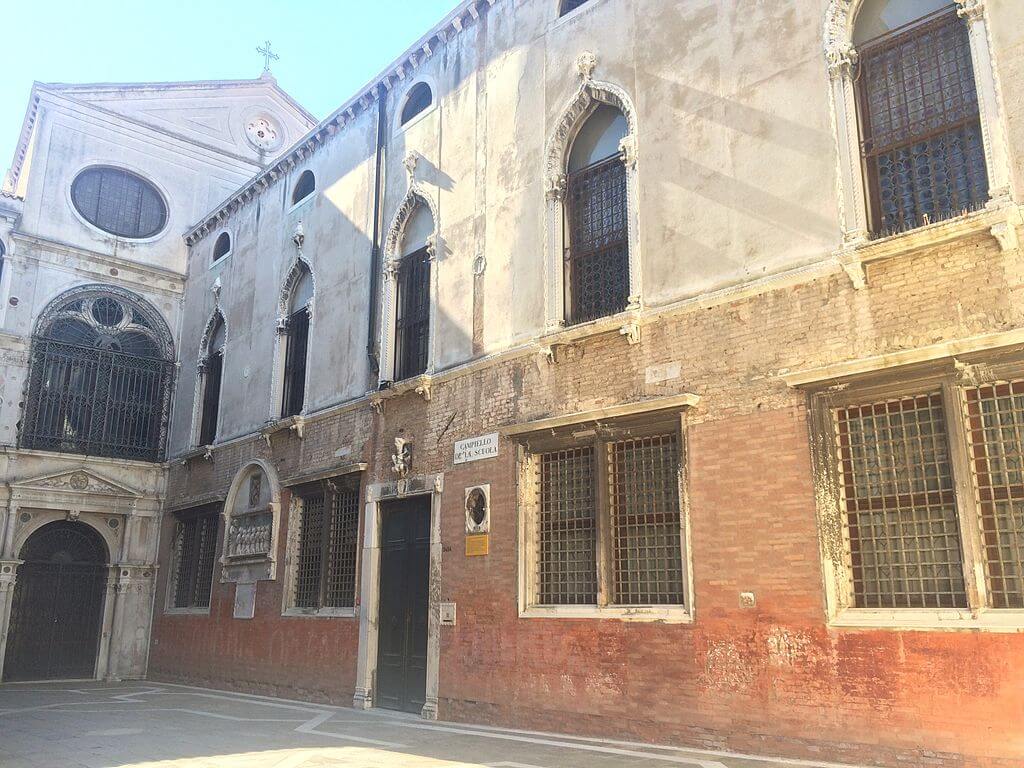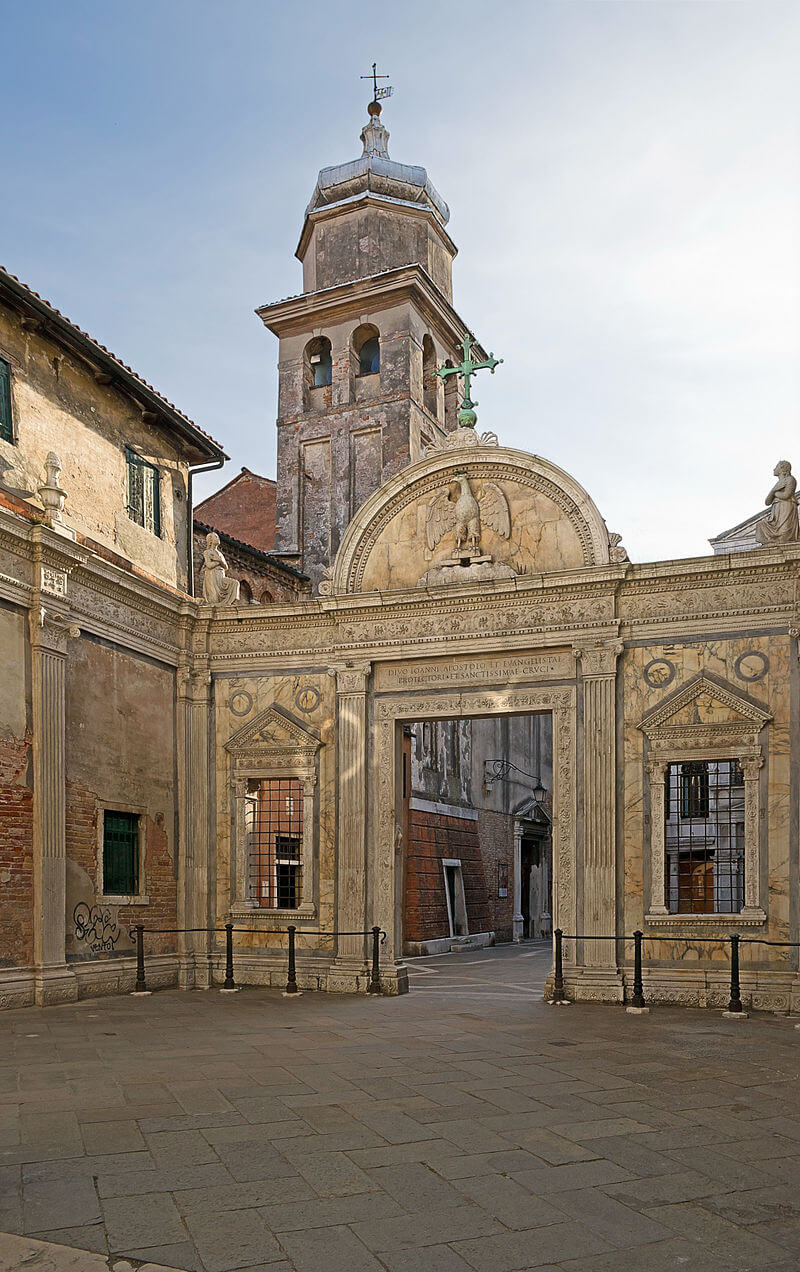Scuola Grande di San Giovanni Evangelista
 Monumenti
Monumenti
Descrizione
La Scuola Grande di San Giovanni Evangelista è una scuola di Venezia, situata nel sestiere di San Polo, presso la Chiesa di San Giovanni Evangelista.È la scuola di più antica fondazione fra quelle ancora funzionanti sul territorio della città.
Fondata nel 1261, la Scuola di San Giovanni, una delle più ricche e prestigiose di Venezia, era una corporazione di Battuti, che riuniva attorno a sé la devozione per il proprio santo patrono san Giovanni Evangelista. Inizialmente la sua sede era a Sant'Aponal, ma presto si trasferì a San Stin. Nel 1369 la Scuola ricevette un frammento della Vera Croce, da Philip de Mezières, cancelliere dei regni di Cipro e di Gerusalemme, che divenne da allora subito simbolo della Scuola ed oggetto di una straordinaria venerazione.
Nel XV secolo la sede della Scuola fu ristrutturata e ampliata, grazie a donazioni, e negli anni 1414-1420 venne ricostruita. Divenuta Scuola Grande, sotto la sovrintendenza del Consiglio dei Dieci, fu deciso di impreziosire la sede con opere d'arte. Il primo a lavorarci fu Jacopo Bellini, le cui opere presto deperirono. Nel secondo Quattrocento proseguirono anche i lavori architettonici, in particolar modo la transenna che fa da ingresso al cortile, il cui autore è tuttora sconosciuto in quanto si conosce solo l'anno di conclusione dei lavori, il 1481.
Successivamente si decise di collocare nella Sala Grande della confraternita una serie di teleri sui miracoli della reliquia della Croce a Venezia, alla cui creazione furono chiamati, tra il 1496 e il 1501, alcuni dei principali artisti attivi in città. Gentile Bellini dipinse tre teleri, due Giovanni Mansueti, uno Vittore Carpaccio, uno Lazzaro Bastiani e uno Benedetto Diana. Un nono era stato dipinto dal Perugino, ma non si è conservato; tutti gli altri sono nelle Gallerie dell'Accademia.
Nel Cinquecento intervenne anche Tiziano, dipingendo la Visione di san Giovanni Evangelista (ora alla National Gallery di Washington) per il soffitto della Sala dell'Albergo.
Tra 1727 e 1762, un altro artista, Giorgio Massari, fu chiamato a dare l'aspetto che ancora oggi ha la Sala Capitolare; nello stesso secolo Jacopo Guarana dipinse per la scuola Visione dei sette angeli e dei sette vasi.
Solo dopo cinque secoli e mezzo di attività, causa l'editto del 1807 di Napoleone, la Scuola di San Giovanni viene soppressa, come tutte le altre per essere ricostituita nel 1856.
Il complesso della Scuola Grande è accessibile attraverso il portale del setto che chiude il campiello sul quale guarda la facciata con l'ingresso.
È proprio il setto, l'elemento architettonico che conferisce importanza artistica all'esterno del complesso, impressionando chi passa per la stretta Calle de l'Olio con i suoi decori scultorei rinascimentali; sulla struttura architravata , centralmente, è posta una lunetta con i simboli scolpiti della scuola: una grande aquila (simbolo dell'evangelista) posata su tre libri e sovrastata da croce.
Sul portale d'ingresso rettangolare, oltre a un mascherone centrale, sono presenti negli angoli dell'architrave due piccoli bassorilievi con frati inginocchiati nell'atto di pregare, mentre alla sinistra dell'ingresso ha luogo un bassorilievo di grandi dimensioni con, in alto, Madonna con Bambino e, inquadrati sotto, i confratelli della Scuola Grande riuniti in preghiera davanti al santo protettore. Le aperture del piano nobile sono monofore a sesto acuto.
Fonte: Wikipedia
The Scuola Grande di San Giovanni Evangelista is a confraternity building located in the San Polo sestiere of the Italian city of Venice. Founded in the 13th century by a group of flagellants it was later to become one of the five Scuole Grandi of Venice. These organisations provided a variety of charitable functions in the city as well as becoming patrons of the arts. The Scuola Grande di San Giovanni Evangelista is notable for housing a relic of the true cross and for the series of paintings it commissioned from a number of famous Venetian artists depicting Miracles of the Holy Cross. No longer in the school, these came into public ownership during the Napoleonic era and are now housed in the Gallerie dell'Accademia. The scuola is open to visitors on a limited number of days, detailed on the official website.
Originally founded in 1261, San Giovanni Evangelista is the second oldest scuola in Venice. Though scuola developed a primary meaning of "school", in Venice these organisations retain their medieval Latin meaning of confraternities, social organisations founded on spiritual principles. Their main buildings were typically used as meeting and assembly halls, and for the distribution of charity. The founders of San Giovanni were a confraternity of flagellants who took part in religious ceremonies, whipping their backs and spraying blood onto the pavements as they processed through the city. This practice was outlawed in the city of Venice in the same year the scuola was founded.
In 1369 Philip de Mezières (also known as Filippo Maser), the Chancellor of the Kingdom of Jerusalem and the Kingdom of Cyprus, gave to the school a piece of the true cross which it still owns to this day. The presence of this relic brought about a transformation and helped the scuola become a rich and powerful organisation, bringing in wealthy and powerful members to the confraternity, with their donations and bequests.
Members of the Vendramin Family Venerating a Relic of the True Cross, Titian and workshop, mid-1540s, showing the reliquary still owned by the scuola[6]A reliquary was constructed to house the relic and this was soon after connected with a miracle that reportedly took place in Venice during the period 1370-82. According to contemporary accounts, when accidentally dropped into a canal during a congested procession the relic did not sink but hovered over the water, evading those trying to save it. This continued until Andrea Vendramin (grandfather of the only Vendramin doge, also named Andrea) dived in and retrieved it.[7] This was the same Andrea who, as head of the scuola, had been presented with the relic in 1369.[8] This miracle was later depicted by Vittorio Carpaccio, Gentile Bellini and other artists in a series of paintings commissioned for the scuola. Nearly 200 years later the reliquary was the focal point of the Vendramin family portrait by Titian, now in the National Gallery, London, showing the prestige the events had given to the family.
The final major architectural changes were made during the 18th century. Following the fall of the Venetian Republic in 1797 the schools were suppressed by a Napoleonic edict. However, during the 19th century San Giovanni Evangelista was one of the ones re-constituted.
Credits: Wikipedia


